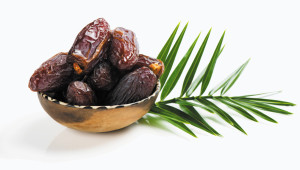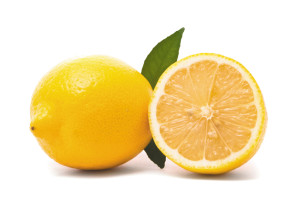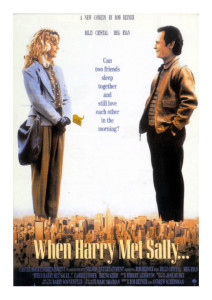Depending upon where and when you read this, Valentine chocolates may be lurking in the immediate vicinity. This is no crime. After six weeks of (mostly) healthy eating this New Year, everyone is entitled to a little diversion, especially in the name of romance. But one minor transgression is no reason to resume gorging like it is December again; so think twice before you take off for the mall to replenish that candy stash.
This is the ideal time of year to visit the farmers’ market, when you can take your time looking over the inventory and ask the growers for their favorite ways to prepare their products. You may be surprised to see a lot more than root vegetables out there. The February market offers plenty of natural sweetness in the form of plump dried fruits, juicy citrus, and silky-smooth local honey. Mixed with some power greens, these simple ingredients will satisfy that sweet tooth and get you right back on the healthy-eating track.
This Moroccan-inspired salad is a nourishing side dish for a grilled chicken breast, especially when paired with artisan whole-grain bread from the farmers’ market. To transform the salad into an entree, serve on a bed of cooked and cooled couscous, quinoa, or white beans; or consider adding other ingredients like coarsely crumbled California goat cheese, ripe avocado chunks, or a generous sprinkling of toasted walnuts or pistachios.
Herbed Salad with Oranges & Dates

3 Cara Cara or other navel oranges
2 teaspoons white wine vinegar
1 teaspoon honey
Fine sea salt
Freshly ground black pepper
3 tablespoons California extra virgin olive oil
6 large handfuls ofmixed salad greens, such as arugula, mizuna, and baby kale or spinach
1/2 small red onion, thinly sliced
4 radishes, thinly sliced
About 1/4 cup cilantro leaves
About 1/4 cup small mint leaves
6 Medjool or other large dates, pitted and sliced lengthwise
1. Cut a slice off both ends of each orange so it will stand upright. Working one at a time, stand an orange on a cutting board with a reservoir to catch the juice, and, using a sharp knife, remove all the peel and white pith by slicing from top to bottom all the way around the orange, following the contour of the fruit. Repeat with the remaining oranges. Slice the peeled oranges crosswise about 1/2-inch thick, and cut the slices into quarters. Pour the accumulated orange juice into a large bowl.
2. To the same bowl, add the vinegar, honey, 1/4 teaspoon salt, and a few grindings of pepper. Stir to blend. Whisk in 2 1/2 tablespoons ofthe olive oil. Add the salad greens, red onion, radishes, cilantro, and mint. Toss to lightly coat the greens. Taste, adding more salt or pepper if needed. Transfer the salad to a large shallow serving bowl or rimmed platter. Arrange the orange quarters over the top and scatter the dates over all. Drizzle with the remaining olive oil, if desired. Serve at once. Makes 4 to 6 servings.
Sweet Salad Savvy
–Navel oranges are an easy choice, since they are seedless. You can certainly substitute crimson-fleshed Blood oranges or any other variety you may have on hand; just be sure to remove the seeds.
–Known for their vitamin C content, oranges are also high in calcium, potassium, vitamin B1 (thiamin), folate, and fiber.
–If, like me, you still have a pomegranate or two hidden away in the produce drawer of your refrigerator, the jewel-like seeds make a delicious garnish when scattered over the top of this salad.
–Dates are thought to be the oldest cultivated fruit—dating back to ancient times–and have been growing in the California desert for more than a century. The climate there is ideal, as date palms thrive with their “feet in water and their heads in the sun.”
–About 90% of dates eaten in the United States are grown in California.
–Searching for the perfect date? The most common varieties are the lean, papery-skinned Deglet Noor, and the moist and meaty Medjool. Ask growers about the lesser-known varieties they may produce, like Halawi and Dayri. (If you’re nice, they may even give you a sample to taste.)
–Opt for dates that still contain the pit—it keeps them moist and supple.
–Tempted by those boxes of diced dates at the supermarket? Don’t waste your money. Coated with an anti-caking agent to keep them from sticking together, they are usually leathery and flavorless.
–Although you can use a small knife to pit dates, the flesh of fresh dates is easily pulled apart with your fingers, so you can simply lift out the pit.
— If you need chopped dates for a recipe, spray kitchen shears or a knife with no-stick cooking spray to make the job less sticky.
–Date arithmetic: 8 ounces pitted dates = about 1 1/2 cups chopped.
–Fresh dates can be refrigerated for up to 2 weeks. Dried dates can be stored in an airtight container at cool room temperature for up to 6 months, or refrigerated for up to 1 year. Dates can also be frozen.
–California dates meet the American Heart Association’s criteria for foods that are low in saturated fat and cholesterol. They are sodium-free, high in fiber and vitamins A and B6, and contain high levels of potassium, a nutrient proven to reduce the risk of hypertension and stroke. Dates are also rich in invert sugars, providing the body with hours of natural energy.
The Danville Certified Farmers’ Market, located at Railroad and Prospect, is open every Saturday, rain or shine, from 9 a.m. until 1 p.m. For specific crop information call the Pacific Coast Farmers’ Market Association at 1-800-949-FARM, or visit their web site at www.pcfma.org. This market is made possible through the generous support of the Town of Danville. Please show your appreciation by patronizing the many fine shops and restaurants located in downtown Danville. Buy fresh. Buy local. Live well!




